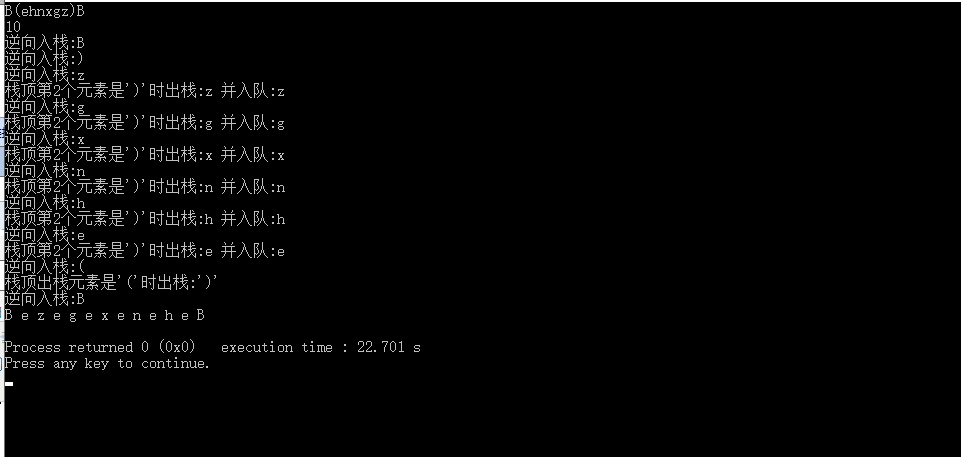数据结构设计——魔王语言
【问题描述】
有一个魔王总是使用自己的一种非常精练而抽象的语言讲话,没有人能听得懂,但他的语言是可以逐步解释成人能听懂的语言,因为他的语言是由以下两种形式的规则由人的语言逐步抽象上去的:

在这两种形式中,从左到右均表示解释。试写一个魔王语言的解释系统,把他的话解释成人能听得懂的话。
【基本要求】
用下述两条具体规则和上述规则形式(2)实现。设大写字母表示魔王语言的词汇;小写字母表示人的语言词汇;希腊字母表示可以用大写字母或小写字母代换的变量。魔王语言可含人的词汇。

【测试数据】
B(ehnxgz)B解释成tsaedsaeezegexenehetsaedsae
有点简单,不想好好做,最后的B A 的替换就省略了:
思路就是用栈,队列实现
#include<stdio.h> #include<stdlib.h> #include<string.h> char say[100]; typedef struct SqStack{ char data[100]; int top,bottom; }SqStack,SqQueue; void ruZhan(SqStack *S,char c){ if(S->top == 100 - 1){ printf("栈满!\n"); }else{ S->top++; S->data[S->top] = c; } } char chuZhan(SqStack *S){ if(S->top == 0){ printf("栈空!\n"); return -1; }else{ char e; e = S->data[S->top]; S->top--; return e; } } void inQueue(SqQueue *Q,char e){ if(Q->bottom == 100 - 1){ printf("队满!\n"); }else{ Q->data[Q->bottom] = e; Q->bottom++; } } char outQueue(SqQueue *Q){ char r = '1'; if(Q->top == Q->bottom){ printf("队空!\n"); }else{ r = Q->data[Q->top]; Q->top++; } return r; } void Init_queue(SqQueue *Q){ if(!Q){ printf("初始化失败!\n"); }else{ Q->top = Q->bottom = 0; } } void Init_Stack(SqStack *S) { if(!S){ printf("初始化失败!\n"); }else{ S->bottom = S->top = 0 ; } } void printS(SqStack *S){ int lon = S->top - S->bottom; if(lon == 0){ printf("栈空!\n"); }else{ for(int i = 1 ; i <= lon;i++){ printf("%c ",S->data[i]); } printf("\n"); } } int main(){ SqStack S; SqQueue Q; Init_queue(&Q); Init_Stack(&S); char bb[9] = "tsaedsae"; char aa[4] = "sae"; scanf("%s",say);getchar(); int lon = strlen(say); printf("%d\n",lon); for(int i = lon -1;i >=0;i--){ printf("逆向入栈:%c\n",say[i]); ruZhan(&S,say[i]); if(S.data[S.top - 1] == ')'){ char x = chuZhan(&S); if(x == '('){ printf("栈顶出栈元素是'('时出栈:')' \n"); chuZhan(&S); int lon2 = Q.bottom - Q.top; char pp = Q.data[Q.bottom-1]; lon2--; while(lon2--){ ruZhan(&S,pp); ruZhan(&S,outQueue(&Q)); } ruZhan(&S,pp); }else{ inQueue(&Q,x); printf("栈顶第2个元素是')'时出栈:%c 并入队:%c\n",x,x); } } } printS(&S); return 0; }




